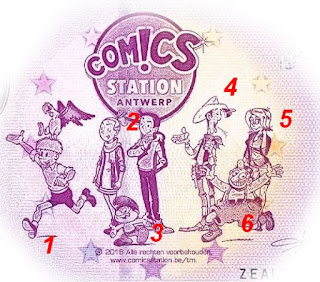Similar to Euro coins, each 0-euro note has a common size, which is common for all notes:
On the 2015 (first) notes, only French buildings were depicted, as only French subject were on the front of each note.
 |
| 2015 version (French buildings only) |
Here we find also the Eiffel tower ....
Pont du Gard (close to Nîmes, Uzès and Avignon) - oldest bridge of France (1st century A.D.)
Mont Saint Michel (Bretagne)
Cathedral of Reims (Reims)
In 2016, the notes were issued in other countries and the design became 'European'
 |
| 2016 version (European buildings) |
It depicts several famous European buildings - how many of them can you recognise and where are they located?
Big Ben (London - United Kingdom)
Brandenbruger Tor (Berlin - Germany)
Collosseum (Rome - Italy)
Eiffel Tower (Paris - France)
Sagrada Familia (Barcelona - Spain)
Manneke Pis statue (Brussels - Belgium)
Mona Lisa (Italy / Louvre Paris France)
Finally in 2017 - because of the Brexit, the design was renewed, and the Big Ben was replaced by another monument ...
Belém Tower (Lissabon - Portugal)
 |
| 2017 and later version (European buildings) |
Besides the 3 different designs at the back of the notes (design A, B and C)
There is also a small difference on the front of the designs :
Design A has extra marks on the border of the note.The notes have a minimum issue of 5,000 copies each, but mostly printed in 10,000 copies.
Some subject were/are so popular, that the topics are reprinted the next year.
On the front of the notes, we find the year of issue, followed by the number of the issue.
Same designs that are repeated, get a '2' or '3' (or higher) behind the year.
A '1' means there is only one version, or this note is the first issued version.
 |
| 2017 issue - version 1 |
 |
| 2018 issue - version 2 |
 |
| 2017 issue - version 3 |
The 0-Euro note of Napoléon I, exists in 3 printings, with 3 different reverse sides.
On the front, the topics started with historical building, famous events or people, but was soon commerialised, and theme parks, cultural heritage, rulers, and even private events were chosen.
You can have your own notes printed, but there is a minimum of 5,000 copies, which will cost you between 5,000 and 10,000 euro (design not included)...
In return you'll get your own 'banknotes', worth at least ... 0 Euro.
to be continued ...






















































